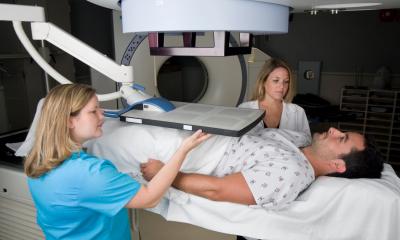Image source: Adobe Stock/Alexandr Mitiuc
News • New imaging approach
Diagnosing prostate cancer with ultrasound
Researchers at Imperial College London, University College London and Imperial College Healthcare NHS Trust have found that a new type of ultrasound scan can diagnose most prostate cancer cases with good accuracy in a clinical trial involving 370 men.
The ultrasound scans missed only 4.3 per cent more clinically important prostate cancer cases – cancer that should be treated rather than monitored – compared to magnetic resonance imaging (MRI) scans currently used to detect prostate cancer. MRI scans are expensive and time-consuming. The team believes that an ultrasound scan should be used as a first test in a community healthcare setting and in low and middle income countries which do not have easy access to high quality MRI scans. They say it could be used in combination with current MRI scans to maximise cancer detection. The study is published in Lancet Oncology.
We believe that this test can be used in low and middle income settings where access to expensive MRI equipment is difficult and cases of prostate cancer are growing
Hashim Ahmed
Professor Hashim Ahmed, lead author of the study and Chair of Urology at Imperial College London, said: “Prostate cancer is the most commonly diagnosed cancer in the UK. One in six men will be diagnosed with the disease in their lifetimes and that figure is expected to rise. MRI scans are one of the tests we use to diagnose prostate cancer. Although effective these scans are expensive, take up to 40 minutes to perform and are not easily available to all. Also, there are some patients who are unable to have MRI scans such as those with hip replacements or claustrophobia fears. As cancer waiting lists build as a result of the Covid-19 pandemic, there is a real need to find more efficient and cheaper tests to diagnose prostate cancer. Our study is the first to show that a special type of ultrasound scan can be used as a potential test to detect clinically significant cases of prostate cancer. The scan detects most cases of prostate cancer with good accuracy, although MRI scans are slightly better. We believe that this test can be used in low and middle income settings where access to expensive MRI equipment is difficult and cases of prostate cancer are growing.”
Prostate cancer is the most common cancer in men in the UK with around 52,300 new cases diagnosed each year. It develops when cells in the prostate grow in an uncontrolled way. Prostate cancer develops slowly and symptoms such as the blood in the urine do not appear until the disease has developed. It usually affects men over 50 and often men with a family history of the disease. Black men are disproportionately impacted by the disease and deaths from prostate cancer have now overtaken those from breast cancer. One of the main methods to diagnose prostate cancer is a special type of magnetic resonance Imaging (MRI) scan called a multi-parametric MRI (mpMRI) scan, which helps doctors see if there is any cancer inside the prostate and how quickly the cancer is likely to grow. However, the scan takes 40 minutes and costs £350-450.
Recommended article

Article • Interdisciplinarity
All for one: a Belgian prostate unit at work
Pathologists, radiologists, urologists and radiotherapy specialists sit at the core of the treatment pathway for the patient, working together as a cohesive unit. In an innovative 2019 ECR session in Vienna, the prostate unit from Ghent University Hospital in Belgium outlined how the team works to deliver the best clinical outcome for patients.
The new study looked at the use of a different kind of imaging called multiparametric ultrasound (mpUSS), which uses soundwaves to look at the prostate. The test involves the use of a probe called a transducer to make the images of the prostate. It is placed into the rectum and it sends out sound waves that bounce off organs and other structures. These are then made into pictures of the organs. The doctor doing the test also uses extra special types of ultrasound imaging that look at how stiff the tissue is and how much blood supply tissue has. These are called elastography, doppler and contrast-enhancement with microbubbles. As cancers are more dense and have greater blood supply, they show up more clearly. Although mpUSS is more widely available than mpMRI there has been no large-scale studies to validate its effectiveness as a test to detect prostate cancer cases.
In the new trial, called cancer diagnosis by multiparametric ultrasound of the prostate (CADMUS), the team recruited 370 men at risk of prostate cancer. They were identified following initial tests such as a prostate-specific antigen (PSA) test – a blood test to help detect prostate cancer – and/or an abnormal digital rectal examination – a test that examines a person's lower rectum, pelvis, and lower belly. The study took place at seven hospitals in the UK including lead site Charing Cross Hospital, part of Imperial College Healthcare NHS Trust, between March 2016-November 2019.
The men were given both mpUSS and mpMRI scans at separate visits. This was then followed by biopsies – which involves using thin needles to take small samples of tissue from the prostate to analyse under a microscope to check cancer – for 257 patients who had a positive mpUSS or mpMRI test result. The team then compared the results from the tests. Cancer was detected in 133 men, with 83 men diagnosed with clinically significant cancer. Individually, mpUSS detected 66 cases of clinically significant cancer compared to mpMRI which detected 77 cases. Although mpUSS detected 4.3 per cent fewer clinically-important prostate cancers compared to mpMRI the researchers said this method would lead to 11.1 per cent more patients being biopsied. This was because the mpUSS sometimes showed up abnormal areas even though there was no cancer.
The researchers believe that the test can be used as an alternative to mpMRI as a first test for patients at risk of prostate cancer, particularly where mpMRI cannot be carried out. Both imaging tests missed clinically-important cancers detected by the other, so using both would increase the detection of clinically-important prostate cancers compared to using each test alone. First author, Dr Alistair Grey (UCL Division of Surgery & Interventional Science), said: “Our results provide an accurate test for prostate cancer in patients who were previously without one using a scan that’s cheap and easy to conduct.”
Source: Imperial College London
02.03.2022











